The Glass Bonding Adhesive Market is estimated to be valued at USD 4.2 billion in 2025 and is projected to reach USD 7.4 billion by 2035, registering a compound annual growth rate (CAGR) of 5.7% over the forecast period.
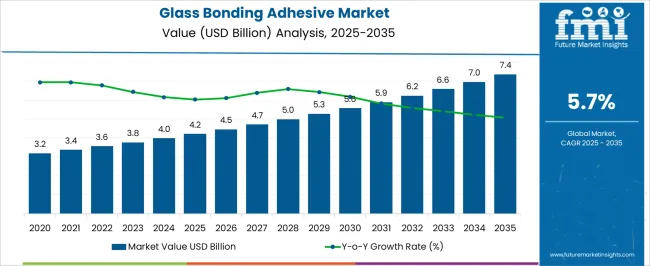
| Metric | Value |
|---|---|
| Glass Bonding Adhesive Market Estimated Value in (2025 E) | USD 4.2 billion |
| Glass Bonding Adhesive Market Forecast Value in (2035 F) | USD 7.4 billion |
| Forecast CAGR (2025 to 2035) | 5.7% |
The Glass Bonding Adhesive market is experiencing steady growth, driven by increasing demand for durable and transparent adhesive solutions across industrial, commercial, and consumer applications. Adoption is being fueled by the need for high-strength bonding in glass assemblies without compromising optical clarity or structural integrity. Advancements in adhesive chemistry, particularly in UV curable and hybrid formulations, have enhanced curing speed, bonding strength, and resistance to environmental factors such as heat, moisture, and chemicals.
The integration of adhesives into automated production lines for glass panels, furniture, automotive components, and electronic devices is further accelerating adoption. Rising emphasis on lightweight and aesthetically appealing designs has increased the demand for transparent bonding solutions, particularly in high-end furniture and architectural applications.
Regulatory requirements for low volatile organic compound content and environmentally friendly formulations are also shaping market trends As manufacturers focus on operational efficiency, durability, and product aesthetics, the Glass Bonding Adhesive market is expected to sustain long-term growth, supported by continuous innovation and increasing application diversity across sectors.
The glass bonding adhesive market is segmented by type, end-use industry, and geographic regions. By type, glass bonding adhesive market is divided into UV Curable Acrylate, Silicone, UV Curable Epoxy, Polyurethane, and Others. In terms of end-use industry, glass bonding adhesive market is classified into Furniture, Electronics, Transportation, Medical, Industrial Applications, and Others. Regionally, the glass bonding adhesive industry is classified into North America, Latin America, Western Europe, Eastern Europe, Balkan & Baltic Countries, Russia & Belarus, Central Asia, East Asia, South Asia & Pacific, and the Middle East & Africa.
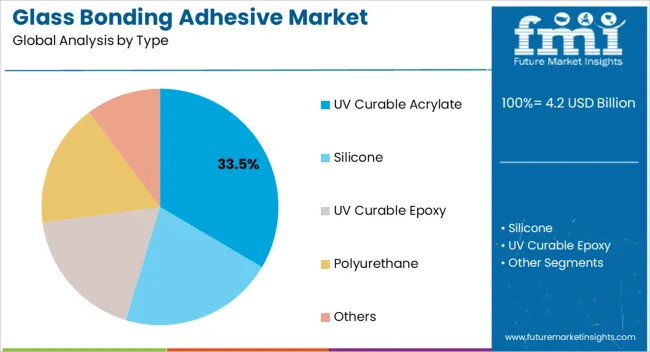
The UV curable acrylate segment is projected to hold 33.5% of the market revenue in 2025, establishing it as the leading product type. Growth in this segment is being driven by its rapid curing capability, high bonding strength, and compatibility with glass, metal, and plastic substrates. The ability to cure on demand with ultraviolet light allows precise control over production processes, reducing waste and increasing manufacturing efficiency.
These adhesives are particularly valued for applications requiring transparency, scratch resistance, and minimal visual distortion, making them suitable for high-end furniture, display panels, and decorative glass products. Their durability under thermal and mechanical stress further enhances adoption in demanding environments.
Integration with automated and robotic assembly lines allows faster processing and consistent performance As manufacturers increasingly seek solutions that improve productivity while maintaining aesthetic appeal and structural reliability, UV curable acrylates are expected to maintain market leadership, supported by ongoing research in high-performance formulations and advanced curing technologies.
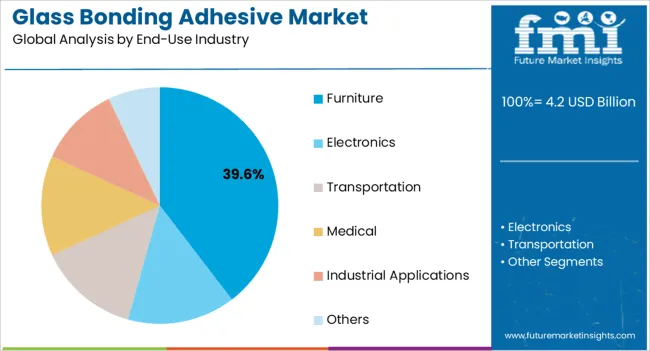
The furniture end-use industry segment is anticipated to account for 39.6% of the market revenue in 2025, making it the largest application sector. Growth in this segment is driven by the rising demand for durable, transparent, and aesthetically appealing glass furniture, including tables, cabinets, partitions, and decorative pieces. Glass bonding adhesives are preferred over mechanical fasteners because they provide seamless joints, maintain design integrity, and enhance structural stability.
The ability to accommodate complex shapes and large glass surfaces without compromising safety or appearance has further reinforced adoption. Manufacturers are increasingly leveraging UV curable and high-strength adhesives to meet the growing expectations for modern furniture that combines elegance with functionality.
Environmental compliance, reduced processing times, and integration into automated assembly lines have enhanced efficiency and scalability for large-scale production As urbanization and premium furniture consumption increase, the furniture segment is expected to remain the dominant end-use industry, supported by innovation in adhesive technology and the rising adoption of glass-based interior design solutions.
The use of adhesives and glues as a bonding agent between glass and other materials is increasing now a days. The glass bonding adhesives has a wide renege of applications in automotive industry for bonding the glass in vehicles, manufacturing of water tanks and optical glasses, bonding of window glass to frame or structure etc. The selection of a suitable adhesive for proper bonding of glass depends upon various factors such as loads and stresses at which the glass must resist, functional and technical requirement of a joint etc.
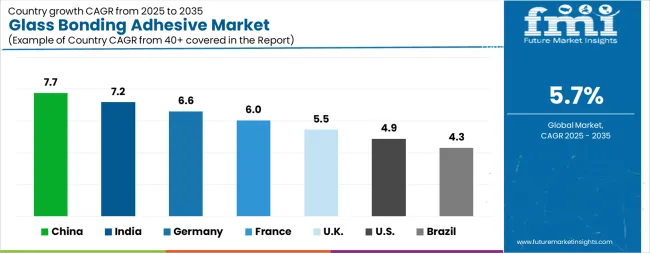
| Country | CAGR |
|---|---|
| China | 7.7% |
| India | 7.2% |
| Germany | 6.6% |
| France | 6.0% |
| UK | 5.5% |
| USA | 4.9% |
| Brazil | 4.3% |
The Glass Bonding Adhesive Market is expected to register a CAGR of 5.7% during the forecast period, exhibiting varied country level momentum. China leads with the highest CAGR of 7.7%, followed by India at 7.2%. Developed markets such as Germany, France, and the UK continue to expand steadily, while the USA is likely to grow at consistent rates. Brazil posts the lowest CAGR at 4.3%, yet still underscores a broadly positive trajectory for the global Glass Bonding Adhesive Market. In 2024, Germany held a dominant revenue in the Western Europe market and is expected to grow with a CAGR of 6.6%. The USA Glass Bonding Adhesive Market is estimated to be valued at USD 1.5 billion in 2025 and is anticipated to reach a valuation of USD 2.4 billion by 2035. Sales are projected to rise at a CAGR of 4.9% over the forecast period between 2025 and 2035. While Japan and South Korea markets are estimated to be valued at USD 200.6 million and USD 107.5 million respectively in 2025.
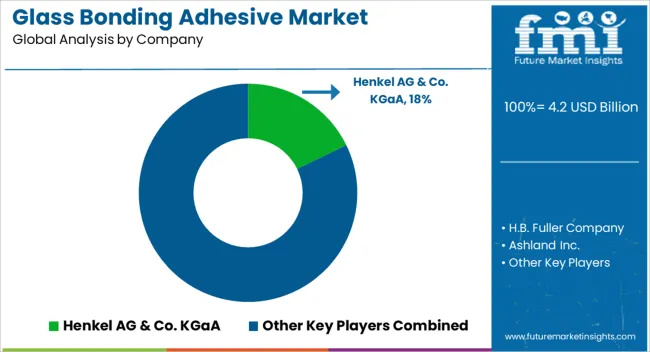
| Item | Value |
|---|---|
| Quantitative Units | USD 4.2 Billion |
| Type | UV Curable Acrylate, Silicone, UV Curable Epoxy, Polyurethane, and Others |
| End-Use Industry | Furniture, Electronics, Transportation, Medical, Industrial Applications, and Others |
| Regions Covered | North America, Europe, Asia-Pacific, Latin America, Middle East & Africa |
| Country Covered | United States, Canada, Germany, France, United Kingdom, China, Japan, India, Brazil, South Africa |
| Key Companies Profiled | Henkel AG & Co. KGaA, H.B. Fuller Company, Ashland Inc., Dymax Corporation, 3M Company, Permabond Engineering Adhesives, The Dow Chemical Company, Bohle Group, KIWO, ThreeBond Holdings Co., Ltd., and Sika A.G. |
The global glass bonding adhesive market is estimated to be valued at USD 4.2 billion in 2025.
The market size for the glass bonding adhesive market is projected to reach USD 7.4 billion by 2035.
The glass bonding adhesive market is expected to grow at a 5.7% CAGR between 2025 and 2035.
The key product types in glass bonding adhesive market are UV curable acrylate, silicone, UV curable epoxy, polyurethane and others.
In terms of end-use industry, furniture segment to command 39.6% share in the glass bonding adhesive market in 2025.






Our Research Products

The "Full Research Suite" delivers actionable market intel, deep dives on markets or technologies, so clients act faster, cut risk, and unlock growth.

The Leaderboard benchmarks and ranks top vendors, classifying them as Established Leaders, Leading Challengers, or Disruptors & Challengers.

Locates where complements amplify value and substitutes erode it, forecasting net impact by horizon

We deliver granular, decision-grade intel: market sizing, 5-year forecasts, pricing, adoption, usage, revenue, and operational KPIs—plus competitor tracking, regulation, and value chains—across 60 countries broadly.

Spot the shifts before they hit your P&L. We track inflection points, adoption curves, pricing moves, and ecosystem plays to show where demand is heading, why it is changing, and what to do next across high-growth markets and disruptive tech

Real-time reads of user behavior. We track shifting priorities, perceptions of today’s and next-gen services, and provider experience, then pace how fast tech moves from trial to adoption, blending buyer, consumer, and channel inputs with social signals (#WhySwitch, #UX).

Partner with our analyst team to build a custom report designed around your business priorities. From analysing market trends to assessing competitors or crafting bespoke datasets, we tailor insights to your needs.
Supplier Intelligence
Discovery & Profiling
Capacity & Footprint
Performance & Risk
Compliance & Governance
Commercial Readiness
Who Supplies Whom
Scorecards & Shortlists
Playbooks & Docs
Category Intelligence
Definition & Scope
Demand & Use Cases
Cost Drivers
Market Structure
Supply Chain Map
Trade & Policy
Operating Norms
Deliverables
Buyer Intelligence
Account Basics
Spend & Scope
Procurement Model
Vendor Requirements
Terms & Policies
Entry Strategy
Pain Points & Triggers
Outputs
Pricing Analysis
Benchmarks
Trends
Should-Cost
Indexation
Landed Cost
Commercial Terms
Deliverables
Brand Analysis
Positioning & Value Prop
Share & Presence
Customer Evidence
Go-to-Market
Digital & Reputation
Compliance & Trust
KPIs & Gaps
Outputs
Full Research Suite comprises of:
Market outlook & trends analysis
Interviews & case studies
Strategic recommendations
Vendor profiles & capabilities analysis
5-year forecasts
8 regions and 60+ country-level data splits
Market segment data splits
12 months of continuous data updates
DELIVERED AS:
PDF EXCEL ONLINE
Metal Bonding Adhesives Market
Temporary Bonding Adhesives Market Size and Share Forecast Outlook 2025 to 2035
Glass Rolling Forming Machine Market Size and Share Forecast Outlook 2025 to 2035
Glass Liquor Bottle Market Size and Share Forecast Outlook 2025 to 2035
Glass Bottles Market Forecast and Outlook 2025 to 2035
Glass Laser Engraving Machine Market Size and Share Forecast Outlook 2025 to 2035
Glass Restoration Kit Market Size and Share Forecast Outlook 2025 to 2035
Glass Bottle and Container Market Forecast and Outlook 2025 to 2035
Bonding Sheet Market Forecast and Outlook 2025 to 2035
Glass Additive Market Forecast and Outlook 2025 to 2035
Adhesives for Electric Vehicle Power Batteries Market Forecast and Outlook 2025 to 2035
Glass Reactor Market Size and Share Forecast Outlook 2025 to 2035
Glass Cosmetic Bottle Market Size and Share Forecast Outlook 2025 to 2035
Adhesive Films Market Size and Share Forecast Outlook 2025 to 2035
Adhesive Tester Market Size and Share Forecast Outlook 2025 to 2035
Glass & Metal Cleaner Market Size and Share Forecast Outlook 2025 to 2035
Glass Product Market Size and Share Forecast Outlook 2025 to 2035
Glassine Paper Market Size and Share Forecast Outlook 2025 to 2035
Glass Container Market Size and Share Forecast Outlook 2025 to 2035
Bonding Honeycomb Vibration Isolation Platform Market Size and Share Forecast Outlook 2025 to 2035

Thank you!
You will receive an email from our Business Development Manager. Please be sure to check your SPAM/JUNK folder too.
Chat With
MaRIA